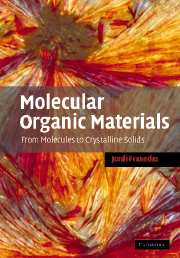Book contents
- Frontmatter
- Contents
- Preface
- List of abbreviations and symbols
- List of chemical abbreviations
- 1 An introduction to molecular organic materials
- 2 Building molecules: molecular engineering
- 3 Building materials: crystal engineering
- 4 Interfaces
- 5 Thin-film growth: from 2D to 3D character
- 6 A miscellany of physical properties
- Afterword
- Appendix A
- Appendix B
- References
- Index
1 - An introduction to molecular organic materials
Published online by Cambridge University Press: 23 November 2009
- Frontmatter
- Contents
- Preface
- List of abbreviations and symbols
- List of chemical abbreviations
- 1 An introduction to molecular organic materials
- 2 Building molecules: molecular engineering
- 3 Building materials: crystal engineering
- 4 Interfaces
- 5 Thin-film growth: from 2D to 3D character
- 6 A miscellany of physical properties
- Afterword
- Appendix A
- Appendix B
- References
- Index
Summary
Welch Schauspiel! aber ach! ein Schauspiel nur!
Wo fass ich dich, unendliche Natur?
What pageantry! Yet, ah, mere pageantry!
Where shall I, endless Nature, seize on thee?
Johann Wolfgang von Goethe, Faust (Translation by G. M. Priest)Broadly speaking, crystalline molecular organic materials (MOMs) are soft solids with a 3D periodic distribution of organic molecules exhibiting weak intermolecular forces, their cohesion being essentially mediated by dipolar (permanent or fluctuating charges), hydrogen bonding and π–π interactions. The molecules involved in the formation of such materials may be of a purely organic nature (e.g., metal-free) or based on hybrid organic–inorganic combinations (e.g., organo-metallic with transition metals). Solids can be built from molecules of a single species or binary or ternary combinations, and inorganic molecules can also be introduced forming hybrid organic–inorganic materials. Such regular solids are often seen by chemists as supramolecular entities, the solid as a macromolecule, in spite of their discrete character, while physicists tend to think in terms of a weakly interacting ordered gas, with cohesion energies larger than about 0.2 eV per molecule the typical energies of noble gas crystals. Although describing the same objects, the terminology used by chemists and physicists is usually distinct and scientific discussions are not always fully synthesized, hindering the desired effective flow of ideas. One of the objectives of this book is to bring both scientific communities to a common neutral playground to better understand the inherently interdisciplinary, rich, complex and exciting field of crystalline MOMs, which involves both experimental and theoretical chemists and physicists and material scientists.
- Type
- Chapter
- Information
- Molecular Organic MaterialsFrom Molecules to Crystalline Solids, pp. 1 - 84Publisher: Cambridge University PressPrint publication year: 2006

